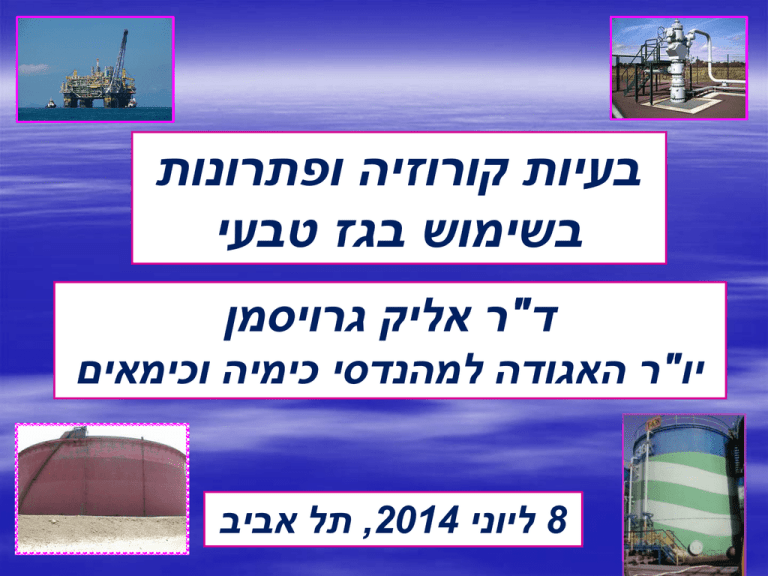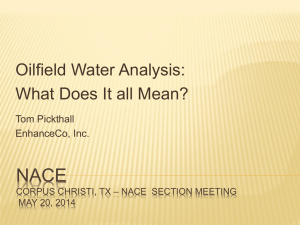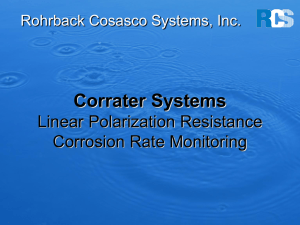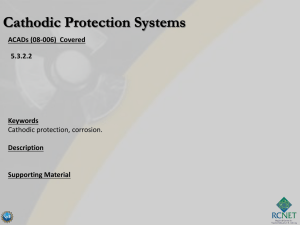Slide 1
advertisement

בעיות קורוזיה ופתרונות בשימוש בגז טבעי ד"ר אליק גרויסמן יו"ר האגודה למהנדסי כימיה וכימאים 8ליוני ,2014תל אביב Typical Composition of Natural Gas Methane Ethane Propane Butane Carbon dioxide Oxygen Nitrogen Hydrogen sulphide Rare gases CH4 C2H6 C3H8 C4H10 CO2 O2 N2 H2S He, Ne, Ar, Xe 70-90% 0 - 20% 0-8% 0-0.2% 0-5% 0-5% trace Trace Component Recovery or Removal 1. Hydrogen 2. Oxygen 3. Radon (Naturally occurring radioactive material, NORM) 4. Arsenic As(CH3)3 - gas < 1 mg/m3 5. Helium If ≥ 0.3 vol% 6. Mercury ≤ 0.01 mg/m3 7. Benzene, toluene, ethylbenzene, and xylene (BTEX) Mercury an element found in trace amounts in most hydrocarbon formations. Hg Liquid metal embrittlement (a form of SCC) – Al ! Mercury removal systems are placed before the aluminum heat exchangers on offshore processing platforms Gas Quality Daily Report (mole %, avg) – 17.01.2012 Methane Ethane 99.46 0.1893 Propane 0.0270 i - Butane 0.0050 n - Butane 0.0030 i - Pentane 0.0019 n - Pentane 0.0012 C6+ 0.0093 Nitrogen 0.1952 Carbon dioxide 0.1083 Corrosiveness of Natural Gas H2O CO2 “sweet” corrosion H2S “sour” corrosion [H2S] > 4 ppmV O2 ? Corrosion problems start if [O2] > 50 ppmv Gas Treating Some pipelines have specifications < 10 ppmv O2 Oxygen causes problems in gas processing: • Enhancing pipeline corrosion if liquid water is present. • • Reacting with amines in gas treating – corrosive compound formation. Reacting with glycols – corrosive acidic compounds. The effect of dissolved gases on the corrosion of carbon steel ppm Dissolved gas concentration in water phase, ppm Measures against oxygen corrosion : - Inert gas blankets over storage tanks; - Oxygen scavengers; - Corrosion inhibitors; - Protective coatings; - Cathodic protection of water-wetted interior surfaces of process vessels and storage tanks. CO2 corrosion : CO2 is not corrosive provided it stays dry. pH = 4 – 4.5 Acidic rain CaCO3 scale may be protective ! CO2(g) + H2O(l) → H2CO3(aq) Mesa corrosion Mesa corrosion looks like the United States` Mesa Mountains, California Mesa corrosion Measures against CO2 corrosion : - Corrosion inhibitors; This may not work at high T - Application of hydrate preventer (glycol) - 9% Cr for downhole tubing; SCC ! - Martensitic SS ( > 12 %Cr) and other CRA; - pH control with caustic soda (NaOH). H2S corrosion Gas that contains sulphur is termed sour gas, and the most form of sulphur is H2S gas H2S is very toxic. Its release can cause death within seconds ! H2O(l) H2S(g) → H2S(aq) pH = 4 – 4.5 MIC – Microbiologically Induced Corrosion Fe(s) + H2S(aq) FeS(s) + H2(g) Black fine powder – can be pyrophoric in pipelines and metering FeS Cu Ni H2S can lead to metal cracking: - Sulphide Stress Cracking (SSC) - Hydrogen Stress Cracking (HSC) - Hydrogen Induced Cracking (HIC) - Stress-oriented hydrogen Induced Cracking (SOHIC) Long-life oilfield equipment should be designed for sour conditions even if the production starts out non-corrosive ! International Standard NACE MR 0175/ISO 15156 Petroleum and Natural Gas Industries – Materials for use in H2Scontaining Environments in Oil and Gas Production NACE MR0175/ISO 15156 consists of 3 parts: · Part 1 - General Principles for Selection of Cracking - Resistant Materials; · Part 2 - Cracking - Resistant Carbon and Low Alloy Steels; · Part 3 - Cracking-Resistant CRAs (Corrosion-Resistant Alloys) and Other Alloys Hardness HRC < 22 ! Austenitic stainless steels (e.g. 304, 316) are limited to a maximum service temperature of 60°C Aluminum can be used without restrictions to PH2S, Cl-, pH H2S detection ASTM D1838 -12, Standard Test Method for Copper Strip Corrosion by Liquefied Petroleum Gases. Copper fittings can corrode. ASTM D4084 - 07 (2012), Standard Test Method for Analysis of H2S in Gaseous Fuels (Lead Acetate Reaction Rate Method). A lead acetate-coated tape darkens in the presence of H2S (0.1 ppmv). Control of H2S Corrosion and Cracking - pH control (NaOH use) - H2S scavengers - Corrosion inhibitors - Internal coatings (organic or cement) Organic acids oilfield corrosion HCOOH, CH3COOH – weak acids Their presence is most important at high pressures in gas condensate SCALE Solids in oil and gas production: CaCO3, CaSO4, BaSO4, CaSiO3 Changes in chemistry (Conc., pH), T and P Scale generally keeps metals dry and reduces uniform corrosion. When scale is imperfect – CORROSION ! Scale is abrasive – EROSION Tubing, Casing and Capillary Tubing Most corrosion problems in oil and gas production are associated with tubing and casing. The reason for this is the large volume of these components used per well. While it is common to use CRAs for wellhead equipment, pumps, packers, economic incentives and availability drive the trends for continued use of CS and low-alloy tubing and casing. Tubing Corrosion The cost of tubing replacement can be upward of $1 million per well, and many operators have adopted the policy of starting oil well production with 13Cr tubing in the hopes that they can avoid tubing replacement at some time in the future. NORSOK standard M-001 2004 Material Selection recommendations for various well components to include tubing and liners. Casing Corrosion Casing is the structural retainer for the walls in oil and gas wells. About 75% by weight of oil country tubular good (OCTG) shipments are for casing, which is intended to last for the life of the wells and not be pulled, inspected, or replaced. Corrosion of casing can be from either the interior, in the annular spaces shared with tubing exteriors, or on the exterior. Most corrosion control of casing interiors is by appropriate alloy selection and by packer fluid inhibitor use, either filming inhibitors at lower T, or O2, CO2 and H2S scavengers at elevated T. Exterior corrosion protection is usually provided by cementing, which provides a high-pH noncorrosive environment for the casing exterior, and by electrical separation at the wellhead with insulated flange assemblies that are intended to isolate the well from flowlines that could produce stray current corrosion. Corrosion control: - Material choice (including corrosion allowance) - Protective coatings - Cathodic protection - Treatment of environment (inhibition, etc.) - Corrosion monitoring: on-line, periodical, scheduled maintenance, and inspection Cathodic Protection קרקעיים-ימיים ותת-קווים ומבנים תת הגנה קתודית+ ציפויים The metallic structures in the atmosphere, in fuels and demineralized water (or other media of high electrical resistance) will not be protected by cathodic protection. 2014 2010






